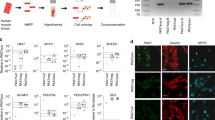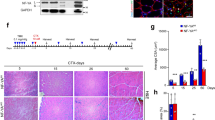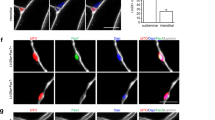Abstract
Satellite cells are resident myogenic progenitors in postnatal skeletal muscle involved in muscle postnatal growth and adult regenerative capacity. Here, we identify and describe a population of muscle-resident stem cells, which are located in the interstitium, that express the cell stress mediator PW1 but do not express other markers of muscle stem cells such as Pax7. PW1+/Pax7− interstitial cells (PICs) are myogenic in vitro and efficiently contribute to skeletal muscle regeneration in vivo as well as generating satellite cells and PICs. Whereas Pax7 mutant satellite cells show robust myogenic potential, Pax7 mutant PICs are unable to participate in myogenesis and accumulate during postnatal growth. Furthermore, we found that PICs are not derived from a satellite cell lineage. Taken together, our findings uncover a new and anatomically identifiable population of muscle progenitors and define a key role for Pax7 in a non-satellite cell population during postnatal muscle growth.
This is a preview of subscription content, access via your institution
Access options
Subscribe to this journal
Receive 12 print issues and online access
$209.00 per year
only $17.42 per issue
Buy this article
- Purchase on Springer Link
- Instant access to full article PDF
Prices may be subject to local taxes which are calculated during checkout







Similar content being viewed by others
References
Endo, T. Stem cells and plasticity of skeletal muscle cell differentiation: potential application to cell therapy for degenerative muscular diseases. Regen Med. 2, 243–256 (2007).
Montarras, D. et al. Direct isolation of satellite cells for skeletal muscle regeneration. Science 309, 2064–2067 (2005).
Chen, J. C. & Goldhamer, D. J. Skeletal muscle stem cells. Reprod. Biol. Endocrinol. 1, 101 (2003).
Asakura, A. Stem cells in adult skeletal muscle. Trends Cardiovasc. Med. 13, 123–128 (2003).
Bischoff, R. Regeneration of single skeletal muscle fibers in vitro. Anat. Rec. 182, 215–235 (1975).
Peault, B. et al. Stem and progenitor cells in skeletal muscle development, maintenance, and therapy. Mol. Ther. 15, 867–877 (2007).
Charge, S. B. & Rudnicki, M. A. Cellular and molecular regulation of muscle regeneration. Physiol. Rev. 84, 209–238 (2004).
Seale, P. et al. Pax7 is required for the specification of myogenic satellite cells. Cell 102, 777–786 (2000).
Collins, C. A. et al. Stem cell function, self-renewal, and behavioral heterogeneity of cells from the adult muscle satellite cell niche. Cell 122, 289–301 (2005).
Bischoff, R. Proliferation of muscle satellite cells on intact myofibers in culture. Dev. Biol. 115, 129–139 (1986).
Hill, M., Wernig, A. & Goldspink, G. Muscle satellite (stem) cell activation during local tissue injury and repair. J. Anat. 203, 89–99 (2003).
Relaix, F., Rocancourt, D., Mansouri, A. & Buckingham, M. A Pax3/Pax7-dependent population of skeletal muscle progenitor cells. Nature 435, 948–953 (2005).
Zammit, P. S., Partridge, T. A. & Yablonka-Reuveni, Z. The skeletal muscle satellite cell: the stem cell that came in from the cold. J. Histochem. Cytochem. 54, 1177–1191 (2006).
Mauro, A. Satellite cell of skeletal muscle fibers. J. Biophys. Biochem. Cytol. 9, 493–495 (1961).
Irintchev, A., Zeschnigk, M., Starzinski-Powitz, A. & Wernig, A. Expression pattern of M-cadherin in normal, denervated, and regenerating mouse muscles. Dev. Dyn. 199, 326–337 (1994).
Gros, J., Manceau, M., Thome, V. & Marcelle, C. A common somitic origin for embryonic muscle progenitors and satellite cells. Nature 435, 954–958 (2005).
Oustanina, S., Hause, G. & Braun, T. Pax7 directs postnatal renewal and propagation of myogenic satellite cells but not their specification. EMBO J. 23, 3430–3439 (2004).
Kuang, S., Kuroda, K., Le Grand, F. & Rudnicki, M. A. Asymmetric self-renewal and commitment of satellite stem cells in muscle. Cell 129, 999–1010 (2007).
Relaix, F. et al. Pax3 and Pax7 have distinct and overlapping functions in adult muscle progenitor cells. J. Cell Biol. 172, 91–102 (2006).
Olguin, H. C. & Olwin, B. B. Pax-7 up-regulation inhibits myogenesis and cell cycle progression in satellite cells: a potential mechanism for self-renewal. Dev. Biol. 275, 375–388 (2004).
Zammit, P. S. et al. Muscle satellite cells adopt divergent fates: a mechanism for self-renewal? J. Cell Biol. 166, 347–357 (2004).
Lepper, C., Conway, S. J. & Fan, C. M. Adult satellite cells and embryonic muscle progenitors have distinct genetic requirements. Nature (2009).
Asakura, A., Seale, P., Girgis-Gabardo, A. & Rudnicki, M. A. Myogenic specification of side population cells in skeletal muscle. J. Cell Biol. 159, 123–134 (2002).
De Angelis, L. et al. Skeletal myogenic progenitors originating from embryonic dorsal aorta coexpress endothelial and myogenic markers and contribute to postnatal muscle growth and regeneration. J. Cell Biol. 147, 869–878 (1999).
LaBarge, M. A. & Blau, H. M. Biological progression from adult bone marrow to mononucleate muscle stem cell to multinucleate muscle fiber in response to injury. Cell 111, 589–601 (2002).
Tamaki, T. et al. Skeletal Muscle-Derived CD34+/45- and CD34-/45- Stem Cells Are Situated Hierarchically Upstream of Pax7+ Cells. Stem Cells Dev. (2008).
Lee, J. Y. et al. Clonal isolation of muscle-derived cells capable of enhancing muscle regeneration and bone healing. J. Cell Biol. 150, 1085–1100 (2000).
Torrente, Y. et al. Intraarterial injection of muscle-derived CD34(+)Sca-1(+) stem cells restores dystrophin in mdx mice. J. Cell Biol. 152, 335–348 (2001).
Polesskaya, A., Seale, P. & Rudnicki, M. A. Wnt signaling induces the myogenic specification of resident CD45+ adult stem cells during muscle regeneration. Cell 113, 841–852 (2003).
Dellavalle, A. et al. Pericytes of human skeletal muscle are myogenic precursors distinct from satellite cells. Nature Cell Biol. 9, 255–267 (2007).
Relaix, F. et al. Pw1, a novel zinc finger gene implicated in the myogenic and neuronal lineages. Dev. Biol. 177, 383–396 (1996).
Schwarzkopf, M., Coletti, D., Sassoon, D. & Marazzi, G. Muscle cachexia is regulated by a p53-PW1/Peg3-dependent pathway. Genes Dev. 20, 3440–3452 (2006).
Nicolas, N., Marazzi, G., Kelley, K. & Sassoon, D. Embryonic deregulation of muscle stress signaling pathways leads to altered postnatal stem cell behavior and a failure in postnatal muscle growth. Dev. Biol. 281, 171–183 (2005).
Coletti, D., Yang, E., Marazzi, G. & Sassoon, D. TNFalpha inhibits skeletal myogenesis through a PW1-dependent pathway by recruitment of caspase pathways. Embo J. 21, 631–642 (2002).
Coletti, D., Moresi, V., Adamo, S., Molinaro, M. & Sassoon, D. Tumor necrosis factor-alpha gene transfer induces cachexia and inhibits muscle regeneration. Genesis 43, 119–127 (2005).
Relaix, F. et al. Pw1/Peg3 is a potential cell death mediator and cooperates with Siah1a in p53-mediated apoptosis. Proc. Natl Acad. Sci. U S. A 97, 2105–2110 (2000).
Relaix, F., Wei, X. J., Wu, X. & Sassoon, D. A. Peg3/Pw1 is an imprinted gene involved in the TNF-NFkappaB signal transduction pathway. Nature Genet. 18, 287–291 (1998).
Seale, P., Ishibashi, J., Scime, A. & Rudnicki, M. A. Pax7 is necessary and sufficient for the myogenic specification of CD45+:Sca1+ stem cells from injured muscle. PLoS Biol. 2, E130 (2004).
Moura-Neto, V. et al. A 28-bp negative element with multiple factor-binding activity controls expression of the vimentin-encoding gene. Gene 168, 261–266 (1996).
Sax, C. M., Farrell, F. X. & Zehner, Z. E. Down-regulation of vimentin gene expression during myogenesis is controlled by a 5′-flanking sequence. Gene 78, 235–242 (1989).
Ontell, M. & Kozeka, K. The organogenesis of murine striated muscle: a cytoarchitectural study. Am. J. Anat. 171, 133–148 (1984).
Ontell, M., Hughes, D. & Bourke, D. Morphometric analysis of the developing mouse soleus muscle. Am. J. Anat. 181, 279–288 (1988).
Hughes, D. S. & Ontell, M. Morphometric analysis of the developing, murine aneural soleus muscle. Dev. Dyn. 193, 175–184 (1992).
Sherwood, R. I. et al. Isolation of adult mouse myogenic progenitors: functional heterogeneity of cells within and engrafting skeletal muscle. Cell 119, 543–554 (2004).
Sacco, A., Doyonnas, R., Kraft, P., Vitorovic, S. & Blau, H. M. Self-renewal and expansion of single transplanted muscle stem cells. Nature 456, 502–506 (2008).
Buckingham, M. et al. The formation of skeletal muscle: from somite to limb. J. Anat. 202, 59–68 (2003).
Tamaki, T. et al. Identification of myogenic-endothelial progenitor cells in the interstitial spaces of skeletal muscle. J. Cell Biol. 157, 571–577 (2002).
Tamaki, T., Akatsuka, A., Yoshimura, S., Roy., R. R. & Edgerton, V. R. New fiber formation in the interstitial spaces of rat skeletal muscle during postnatal growth. J. Histochem. Cytochem. 50, 1097–1111 (2002).
Campion, D. R., Richardson, R. L., Kraeling, R. R. & Reagan, J. O. Changes in the satellite cell population in fetal pig skeletal muscle. J. Anim. Sci. 48, 1109–1115 (1979).
Asakura, A., Komaki, M. & Rudnicki, M. Muscle satellite cells are multipotential stem cells that exhibit myogenic, osteogenic, and adipogenic differentiation. Differentiation 68, 245–253 (2001).
Nowak, J. A., Polak, L., Pasolli, H. A. & Fuchs, E. Hair follicle stem cells are specified and function in early skin morphogenesis. Cell Stem Cell 3, 33–43 (2008).
Fuchs, E. & Horsley, V. More than one way to skin. Genes Dev. 22, 976–985 (2008).
Yamaguchi, A. et al. Peg3/Pw1 is involved in p53-mediated cell death pathway in brain ischemia/hypoxia. J. Biol. Chem. 277, 623–629 (2002).
Johnson, M. D., Wu, X., Aithmitti, N. & Morrison, R. S. Peg3/Pw1 is a mediator between p53 and Bax in DNA damage-induced neuronal death. J. Biol. Chem. 277, 23000–23007 (2002).
Deng, Y. & Wu, X. Peg3/Pw1 promotes p53-mediated apoptosis by inducing Bax translocation from cytosol to mitochondria. Proc. Natl Acad. Sci. USA 97, 12050–12055 (2000).
Mansouri, A., Stoykova, A., Torres, M. & Gruss, P. Dysgenesis of cephalic neural crest derivatives in Pax7-/- mutant mice. Development 122, 831–838 (1996).
Wright, D. E. et al. Cyclophosphamide/granulocyte colony-stimulating factor causes selective mobilization of bone marrow hematopoietic stem cells into the blood after M phase of the cell cycle. Blood 97, 2278–2285 (2001).
Montarras, D., Lindon, C., Pinset, C. & Domeyne, P. Cultured myf5 null and myoD null muscle precursor cells display distinct growth defects. Biol. Cell 92, 565–572 (2000).
McGeachie, J. K. & Grounds, M. D. Initiation and duration of muscle precursor replication after mild and severe injury to skeletal muscle of mice. An autoradiographic study. Cell Tissue Res. 248, 125–130 (1987).
Sanes, J. R., Rubenstein, J. L. & Nicolas, J. F. Use of a recombinant retrovirus to study post-implantation cell lineage in mouse embryos. EMBO J. 5, 3133–3142 (1986).
Jackson, K. A., Snyder, D. S. and Goodell, M. A. Skeletal muscle fiber-specific green autofluorescence: potential for stem cell engraftment artifacts. Stem Cells 22, 180–187 (2004).
Acknowledgements
We gratefully thank F. Relaix for fruitful discussions and critical reading of the manuscript. We thank A. Galy, E. Negroni and L. Arandel for technical advice and C. Blanc (Cytométrie en Flux platform, Institut Fédératif de Recherche 113) for FACs assistance. This work was supported by a grant from the NIH (NCI PO1 CA80058-06, subproject 3), a French Ministry of Research 'Chaire d'Excellence' to D.S. and the Muscular Dystrophy Association of America to D.S. and E.R.G. K.M. is a recipient of an INSERM 'contrat de jeunes chercheurs'. B.C. is a recipient of a grant from Fondation pour la Recherche Médicale (FRM). E.R.G. is supported in part by the Inserm Avenir Program. This work benefited from funding from the European Community's Seventh Framework Programme project OPTISTEM (Optimization of stem cell therapy for degenerative epithelial and muscle diseases contract number Health-F5-2009-223098). The Myology Group is the beneficiary of a Strategic Plan Support from the Association Française contre les Myopathies (AFM) and is affiliated with the Institute of Myology/ Association Institut Myologie.
Author information
Authors and Affiliations
Contributions
All authors designed research; K.J.M., A.P., B.C., A.P. and V.B. performed research; B.C., V.B. and E.R.G. contributed new reagents/analytic tools; all authors analysed data and K.J.M., G.M. and D.A.S. wrote the paper.
Corresponding author
Ethics declarations
Competing interests
The authors declare no competing financial interests.
Supplementary information
Supplementary Information
Supplementary Information (PDF 475 kb)
Supplementary Information
Supplementary Movie 1 (AVI 1157 kb)
Supplementary Information
Supplementary Movie 2 (AVI 5199 kb)
Rights and permissions
About this article
Cite this article
Mitchell, K., Pannérec, A., Cadot, B. et al. Identification and characterization of a non-satellite cell muscle resident progenitor during postnatal development. Nat Cell Biol 12, 257–266 (2010). https://doi.org/10.1038/ncb2025
Received:
Accepted:
Published:
Issue Date:
DOI: https://doi.org/10.1038/ncb2025



